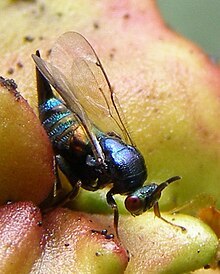
Chalcid wasps are insects within the superfamily Chalcidoidea, part of the order Hymenoptera. The superfamily contains some 22,500 known species, and an estimated total diversity of more than 500,000 species, meaning the vast majority have yet to be discovered and described. The name "chalcid" is often confused with the name "chalcidid", though the latter refers strictly to one constituent family, the Chalcididae, rather than the superfamily as a whole; accordingly, most recent publications (e.g.,) use the name "chalcidoid" when referring to members of the superfamily.

The Ormyridae are a small family of parasitic wasps in the superfamily Chalcidoidea. They are either parasitoids or hyperparasitoids on gall-forming insects, primarily cynipid wasps and tephritid flies. There are 153 species, mostly in the genus Ormyrus); the family has a worldwide distribution, although almost entirely absent from South America.
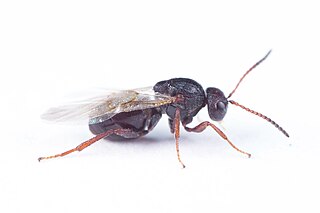
Bassettia is a genus of gall wasps found in North America.
Eurytoma tylodermatis is a species of chalcid wasp in the family Eurytomidae. It is a generalist parasite with over 56 host species.
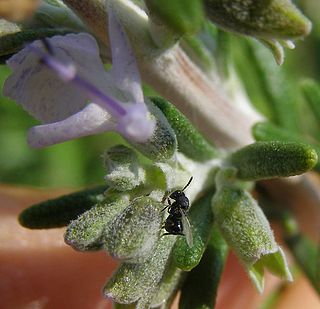
Eurytoma is a genus of parasitoid chalcid wasps in the family Eurytomidae. There are at least 620 described species in Eurytoma.
Amphibolips gainesi is a species of gall wasp in the family Cynipidae.

Euperilampus triangularis is a species of chalcid wasp in the family Perilampidae.

Euperilampus is a genus of chalcid wasps in the family Perilampidae. There are about 18 described species in Euperilampus.
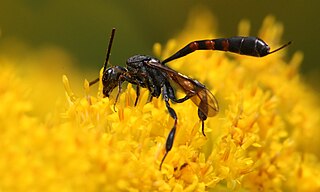
Gasteruption assectator, the wild carrot wasp, is a species of carrot wasp in the family Gasteruptiidae. It is found in the Czech Republic, Slovakia, and Hungary. G. assectator is a generalist inquiline parasitoid of many other bee and wasp species such as Hylaeus confusus, Hylaeus pectoralis, and Pemphredon fabricii.

Minotetrastichus frontalis is a species of chalcid wasp in the family Eulophidae. It is a parasitoid of Phyllonorycter moths, with larvae capable of feeding on both larval and pupal stages of the moth. M. frontalis has four larval stages and three molts, with development lasting eleven days.

Obeza floridana is a species of chalcid wasp in the family Eucharitidae.

Obeza is a genus of chalcid wasps in the family Eucharitidae. There are about eight described species in Obeza.

Orasema occidentalis is a species of chalcid wasp in the family Eucharitidae. The species is a parasite of Pheidole desertorum.
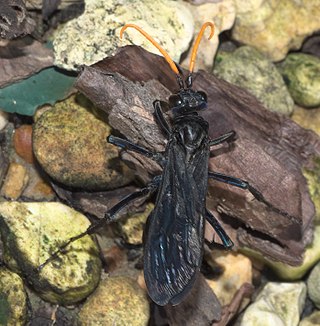
Pepsis menechma, the elegant tarantula hawk, is a species of spider wasp in the family Pompilidae, widely distributed in North America and Central America. It has numerous very different color forms over its range, and has been historically classified as several species.
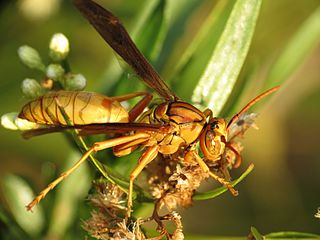
Polistes flavus, also known as the yellow paper wasp, is a species of paper wasp in the family Vespidae.

Pseudochalcura gibbosa is a species of chalcid wasp in the family Eucharitidae. It is associated with ants from the Camponotus genus.

Pseudochalcura is a genus of chalcid wasps in the family Eucharitidae. There are about 14 described species in Pseudochalcura.

Torymus tubicola is a species of chalcid wasp in the family Torymidae.

Ormyrus nitidulus is a parasitoid species of wasp in the family Ormyridae. It is primarily associated with oak gall wasps. Ormyrus nitidulus is a small metallic wasp approximately 5mm long as an adult. It has a fairly widespread distribution being found across North Africa, the Middle East, North America and Europe.
Melanosomellidae is a family of parasitic wasps in the superfamily Chalcidoidea; it includes 31 described genera, which are mostly found the southern hemisphere. Although the biology of most of these wasps is unknown, the larvae and pupae of some species develop in leaf galls or stem galls on various trees.
